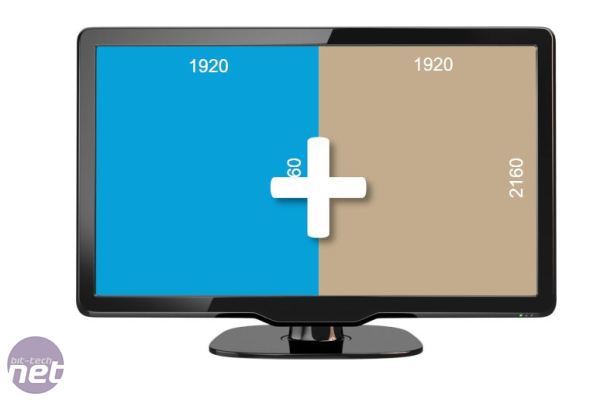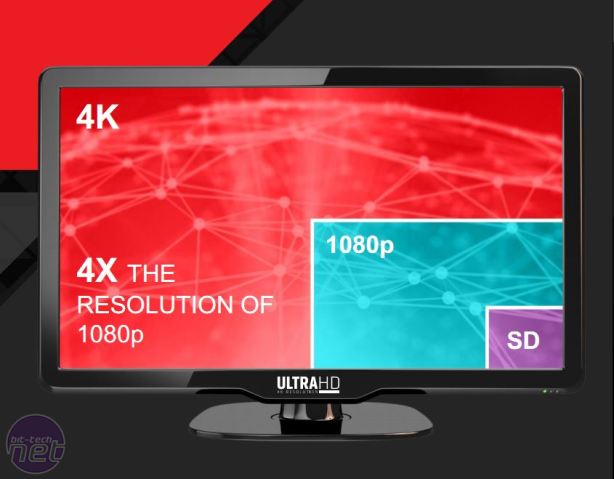All About 4K
A major buzz word in the graphics market at the moment is 4K, which refers to ultra high-definition (UHD) resolutions. With 1080p pretty much the standard resolution for even mid-range gaming now, and even 2,560 x 1,600 becoming less of a challenge for high end cards, 4K is the next logical step for high resolution single screen gaming. As such, a big part of AMD's sales pitch for the R9 290 series is 4K gaming, and they're implementing a few technologies to make life easier for users of this resolution.Part of the current problem with 4K gaming is that it's still very much in its infancy. There are currently very few 4K panels that can run at 60Hz, and while 30Hz is fine for movies, for example, it's pointless for PC users as even mouse movements will feel unbearably sluggish at this refresh rate, let alone games. The panels that can run 4K at 60Hz, such as the Asus PQ321Q and Sharp PN-K321, have to rely on a bit of trickery to do so, as they're actually tiled displays that use two separate 2K tiles side by side to make up the full 3,840 x 2,160 resolution. They'll also set you back more than £2,000, which is the more pressing problem for the majority of us.
The reasons for this tiled approach is mostly to do with display standards. Even though the DisplayPort 1.2 High Bit Rate 2 (HBR2) standard has enough effective bandwidth to support 4K at 60Hz using a single video stream (Single-Stream Transport, or SST), the required input controllers for monitors aren't currently available. It's therefore necessary to use DisplayPort in Multi-Stream Transport (MST) mode to run the two tiles at 60Hz. It's also possible to use two separate HDMI cables from the same source to do it, although it's generally considered less effective. The HDMI 1.4 standard isn't able to power 4K at 60Hz (hence the need for two cables), but thankfully the recently revealed HDMI 2.0 one is.
The problem this presents for 4K gamers (yes, all five of them), is that it typically requires you to manually set-up an Eyefinity configuration for the two tiles (or an Nvidia Surround one if you're so inclined) just to use your single screen. Through driver updates to support specific tiled displays, however, AMD is ensuring that all of its R series parts will detect such displays and automatically apply the correct Eyefinity settings in a plug and play style that you'd expect from a normal monitor. The settings will be maintained across reboots and AMD is creatively referring to the process as Automatic AMD Eyefinity Configuration.
More interestingly, AMD is also supporting a new industry standard called VESA Display ID v1.3 with its R series. Part of this standard is the Tiled Display Topology Data Block, which essentially contains useful data about the individual tiles of supported displays. This data is then leveraged by the Automatic AMD Eyefinity Configuration to provide a more reliable plug and play experience without the need for any driver updates.
AMD has also confirmed that all of its current products support the DP 1.2 HBR2 link rates and as such are ready for 4K 60Hz single stream displays when they become available. They did point out, however, that their R series parts, particularly the R9 290 series, are those which are designed to support the high pixel rates required in such a set-up.
Late into our testing, we managed to get hold of a Sharp PN-K321 display that allows us to test at the 4K resolution of 3,840 x 2,160. As such, we have included results for the R9 290X and Nvidia GTX 780 (using the very latest GeForce 331.58 WHQL drivers) in each of our games. We hope to be able to bring you a fuller range of 4K results in the near future. It's worth mentioning that the Automatic AMD Eyefinity Configuration worked perfectly the first time we booted up with the display attached. Some games, however, would initially display mirrored images in each tile rather than stitching them together, but going into the settings and applying the 3,840 x 2,160 resolution quickly fixed things to fullscreen 4K.

MSI MPG Velox 100R Chassis Review
October 14 2021 | 15:04











Want to comment? Please log in.